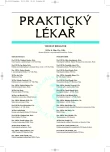-
Medical journals
- Career
Percutaneous endoscopic gastrostomy – experience of one PEG centre in years 2002–2008
Authors: P. Kohout; Z. Beneš; Z. Antoš; M. Rozmahel; G. Puškárová; P. Sokol; M. Černík
Authors‘ workplace: Fakultní Thomayerova nemocnice, Praha ; Primář: MUDr. Zdeněk Beneš, CSc. ; II. interní klinika
Published in: Prakt. Lék. 2008; 88(12): 710-716
Category: Of different specialties
Overview
Percutaneous endoscopic gastrostomy (PEG) is a minimally invasive method used to determine the method for the application of enteral nutrition. It is used for patients who have been identified as needing the long-term application of enteral nutrition (for at least 4–6 weeks). This method has now made surgical gastrostomy almost redundant. Percutaneous endoscopic gastrostomy (PEG) is introduced with the assistance of gastroscopy, mostly using the“pull” method, although in patients with head and neck cancer the “push – introducer” method is preferred. A feeding button is used for the application of enteral nutrition for the long time, it is introduced through gastrocutaneous fistula after extraction of gastrostomic tube. Between 2002 and 2008, 498 PEGs were introduced in 490 patients at the Thomayer’s Hospital PEG Centre (222 males and 268 females, with an average age of 69 – from 3 months old to 98 years old). A feeding button PEG version was used in 48 cases. Mortality associated with the PEG application was 0 %, complications were seen in less than 10 % of cases.
Key words:
enteral nutrition, percutaneous endoscopic gastrostomy (PEG), feeding button.
Sources
1. Anis, M.K., Abid, S., Jafri, W. et al. Acceptability and outcomes of the percutaneous endoscopic gastrostomy (PEG) tube placement-patients’ and care givers’ perspectives. BMC Gastroenterol. 2006, 6, p. 37.
2. Gauderer, M.W.L., Ponsky, J.L., Izant, R.J., Jr. Gastrostomy without laparotomy: a percutaneous endoscopic technique. J. Pediatr. Surg. 1980, 15, p. 872-876.
3. Gauderer, M.W.L. The first PEG. Nutrition 2000, 16, p. 85-86.
4. Kohout, P., Kotrlíková, E. Základy klinické výživy. Praha: Krigl, 2005.
5. Kohout, P., Skládaný, L. Perkutánní endoskopická gastrostomie. Praha: Galén, 2002.
6. Rey, J.R., Axon, A.T.R., Budzynska, A. et al. Guidelines of the European Society of Gastrointestinal Endoscopy (E.S.G.E.): Antibiotic prophylaxis for gastrointestinal endoscopy Endoscopy 1998, 30, p. 318-324.
7. Rimon, E., Kagansky, N., Levy, S. Percutaneous endoscopic gastrostomy; evidence of different prognosis in various patient subgroups. Age and Ageing 2005, 34(4), p. 353-357.
8. Russell, T.R., Brotmann, N., Norris, F. Percutaneous gastrostromy: a new simplified and cost-effective technique. Am. J. Surg. 1984, 184, p. 132-137.
9. Sacks, B.A., Vine, H.S., Palestrant, A.M. et al. A non-operative technique for estabilshement of a gastrostomy in the dog. Invest. Radiol. 1983, 18, p. 485-497.
10. Sanders, D.S., Carter, M.J., D’Silva, J. et al. Survival analysis in percutaneous endoscopic gastrostomy feeding: a worse outcome in patients with dementia. Am. J. Gastroenterol. 2000, 95(6), p. 1472-1475.
11. Schrag, S.P., Sharma, R., Jaik, N.P. et al. Complications related to percutaneous endoscopic gastrostomy (PEG) tubes. A comprehensive clinical review. J. Gastrointestin. Liver Dis. 2007, 16, p. 407-418.
12. Sobotka, L. (ed.) Basics in clinical nutrition. 3rd ed. Praha: Galén, 2004.
13. Wills, J.S., Oglesby, J.T. Percutaneous gastrostomy. Radiology 1983, 149. p. 449-453.
Labels
General practitioner for children and adolescents General practitioner for adults
Article was published inGeneral Practitioner

2008 Issue 12-
All articles in this issue
- A brief review of radiotherapy of rectal cancer
- Spiritual care in Czech hospitals
- Biologic treatment for rheumatoid arthritis
- Alcohol related problems– interaction of risk and protective factors
- Sigmoid volvulus – untypical condition in childhood
- Cardiac rehabilitation – an efficient, but neglected treatment
- Idiopathic thrombocytopenic purpura
- Candida biofilms – a current problem of clinical practice
- Contemporary approaches to osteosynthesis of child fractures
- Tumour markers in prostate cancer. A new horizon?
- Percutaneous endoscopic gastrostomy – experience of one PEG centre in years 2002–2008
- General Practitioner
- Journal archive
- Current issue
- Online only
- About the journal
Most read in this issue- Idiopathic thrombocytopenic purpura
- Percutaneous endoscopic gastrostomy – experience of one PEG centre in years 2002–2008
- Contemporary approaches to osteosynthesis of child fractures
- Sigmoid volvulus – untypical condition in childhood
Login#ADS_BOTTOM_SCRIPTS#Forgotten passwordEnter the email address that you registered with. We will send you instructions on how to set a new password.
- Career

